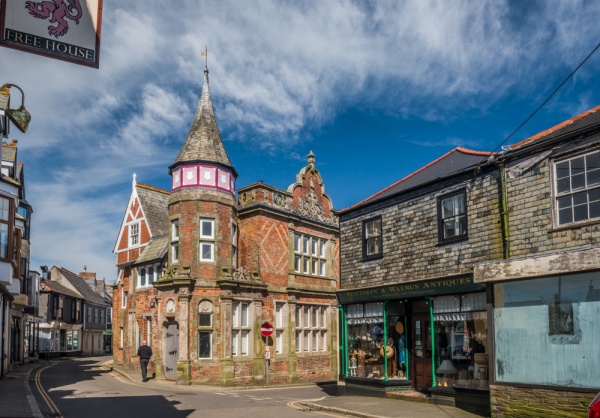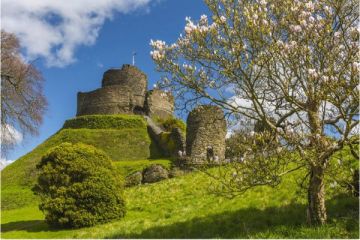
The historic town of St Columb Major is named after Columb, an early Christian female saint who came to Cornwall from southern Scotland. She fled her homeland after her parents wanted her to marry a pagan prince. She landed at Porth, now a popular beach at Newquay, and was pursued by the prince through Rialton and Treloy until he caught and killed her at Ruthvoes, in St Columb Major parish.
A healing spring was said to have burst forth from the ground where Columb was martyred, and you can still see the holy well built upon the site. There was once a chapel beside the well but no trace of it remains.
The medieval parish church is dedicated to St Columba, whose feast is celebrated each 13th November. The present church dates to the 14th century and boasts a striking 15th century west tower. Inside the church are a wonderful collection of memorial brasses to the Arundell family of Laherne, dated to the 16th and 17th century. The Arundells had their own family altar in what is now the south chancel chapel.

The Arundell family association with St Columb Major dates to at least the 14th century. In 1333 King Edward III granted Sir John Arundell the right to hold a weekly market at St Columb Major in thanks for Arundel's support at the Battle of Halidon Hill.
The mayor of St Columb supported the Prayer Book Rebellion of 1549 and was hanged outside a tavern in the town when the Rebellion faltered.
One famous resident of St Columb Major was James Polkinghorne, a famous Cornish wrestler and landlord of the town inn. He died in the town on 15 September 1854. A plaque was set up on the wall of Polkinghorne's inn, commemorating his most famous fight, a contest in 1826 with Abraham Cann, the champion wrestler of Devon.
Polkinghorne was not born in St Columb Major, but one man who did was Ralph Allen (1693 – 1764) who became famous for reforming the postal system and whose life is celebrated in the Bath Postal Museum in Somerset.

Another native of the town was Walter Tripcony, one of the local gentry who plotted to help Perkin Warbeck claim the throne from Henry VII. Tripcony was among those who invited Warbeck to come ashore in Cornwall, and welcomed him at his landing place near Land's End. When Warbeck's revolt went horribly wrong Tripcony's estates were seized by the crown.
One curious local tradition is the annual silver ball 'hurling' competition, held each year on Shrove Tuesday and again 11 days later. Teams of several hundred townsmen and countrymen set up goalposts two miles apart and vie to carry a small silver painted ball made of apple wood through the opposition's goal. The contest is similar to medieval football matches, which often ended in violence and occasionally in deaths.
Thankfully things are a little more civilised today, but local shops still board up their windows to protect them from damage during the spirited contest. The 'playing field' is the entire parish, which measures roughly 25 square miles, making it the largest sporting arena in the world.
The 'major' part of the town name is to distinguish it from the coastal village of St Column Minor.

Aside from the church there are numerous examples of historic buildings, including Bank House, built in 1857 by William White, and The retreat, a former workhouse built by Sir George Gilbert Scott. The oldest building is Glebe House, on the market square. It is easy to spot a rainwater head dated 1638 but that must refer to a restoration, for the house itself dates to the 16th century.
Just east of St Columb Major is Castell an Dinas (Dinas Castle), an Iron Age hillfort dated to the 3rd century BC, while to the north of the town beside the A39 is the Nine Maidens Stone Row, a group of nine standing stones aligned on a north/south axis. Just east of the town is the hamlet of Quoit, named for a prehistoric quoit, or burial chamber.
About St Columb Major
Address: St Columb Major,
Cornwall,
England
Attraction Type: Town
Location: Just off the A39, about five miles east of Newquay
Website: St Columb Major
Location map
OS: SW908630
Photo Credit: David Ross and Britain Express
NEARBY HISTORIC ATTRACTIONS
Heritage Rated from 1- 5 (low to exceptional) on historic interest
St Columb Major, St Columba's Church - 0.5 miles (Historic Church) ![]()
Castle an Dinas Iron Age Hillfort - 2.4 miles (Prehistoric Site) ![]()
Japanese Garden - 2.9 miles (Garden) ![]()
St Mawgan in Pydar Church - 2.9 miles (Historic Church) ![]()
Nine Maidens Stone Row - 3.3 miles (Prehistoric Site) ![]()
St Breock Downs Monolith - 4.9 miles (Prehistoric Site) ![]()
Trerice - 5 miles (Historic House) ![]()
Bedruthan Steps - 5.3 miles (Countryside) ![]()
Nearest Holiday Cottages to St Columb Major:
St Columb Major, Cornwall
Sleeps: 4
Stay from: £397.00 - 3419.00
St Columb Major, Cornwall
Sleeps: 6
Stay from: £441.00 - 2715.00
St Columb Major, Cornwall
Sleeps: 8
Stay from: £529.00 - 3611.00
More self catering near St Columb Major




